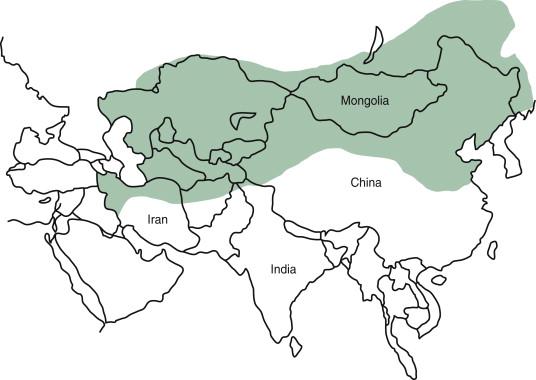Physical Address
304 North Cardinal St.
Dorchester Center, MA 02124
The cancers arising from the esophageal mucosa, primarily esophageal adenocarcinoma (EAC) and esophageal squamous-cell carcinoma (ESCC), are clinically some of the most devastating and lethal cancers in the world. Collectively, they are the eighth most common cancer diagnosed worldwide, with approximately 482,300 new cases in 2008. International age-adjusted incidence rates vary drastically, with a nearly 16-fold difference between the high-incidence areas of southern and eastern Africa and eastern Asia and the low-incidence areas of middle and western Africa and Central America.
Worldwide, ESCC accounts for the majority of esophageal cancers diagnosed, because of its high prevalence in the “esophageal cancer belt,” an area stretching from central Asia to north and central China ( Figure 31-1 ). In this high-risk area, 90% of all esophageal cancers are SCC, with as many as 120 to 175 new cases per 100,000 inhabitants each year. However, the incidence rates of EAC and ESCC vary drastically among geographical regions. In the Western world, EAC has overtaken ESCC as the most prevalent form of esophageal cancer. The United States alone has seen a fourfold increase in EAC since the 1970s.

Regardless of the histology, esophageal cancer carries a high mortality rate because of its advanced stage of presentation, with an overall 5-year survival rate of 17%. It is the sixth most common cause of cancer death worldwide, claiming 4,070,800 lives in 2008. Approximately 86% of these deaths occurred in developing nations, where more than 90% of the esophageal cancers diagnosed were stage 2 or greater.
Ninety-five percent of esophageal cancers are of epithelial origin, occurring as either EAC or SCC, with the remaining tumor histologies comprising malignant melanoma, lymphoma, carcinoid, small cell carcinoma, or sarcoma. Esophageal adenocarcinomas primarily occur in the distal one third of the esophagus and develop through a progressive malignant sequence beginning with cellular metaplasia, then low- and high-grade dysplasia, and eventually to invasive adenocarcinoma. Esophageal squamous-cell carcinoma primarily emerges in the middle to upper third of the esophagus and follows a similar stepwise developmental sequence. However, the initiating histological lesion in the squamous histology is mild to severe dysplasia, followed by carcinoma in situ, and finally invasive squamous-cell carcinoma.
Esophageal adenocarcinoma and squamous-cell carcinoma are two distinct cancers that differ not only in histology and geographical distribution, but also in the risk factors that contribute to their development. However, their risk factors stem from similar pathological processes and also similar molecular mechanisms that lead to tumorigenesis. The pathological processes that initiate these tumorigenic mechanisms stem from chronic irritation and inflammation, carcinogenic exposures, or a combination of both. Unique risk factors of both EAC and ESCC will be highlighted in the context of either chronic inflammation or carcinogenic exposure. More detailed explanations of the epidemiological risk factors associated with EAC and ESCC are covered elsewhere in this text. Simply stated, examples of chronic inflammation can take the form of gastroesophageal reflux as in EAC, or chronic thermal injury of the more proximal esophagus from drinking hot beverages in ESCC. Similarly, carcinogenic exposure can include the high prevalence of tobacco smoking in both EAC and ESCC as well as the high nitrosamine content of the soil and the high consumption of smoked foods in the esophageal cancer belt in ESCC.
Become a Clinical Tree membership for Full access and enjoy Unlimited articles
If you are a member. Log in here